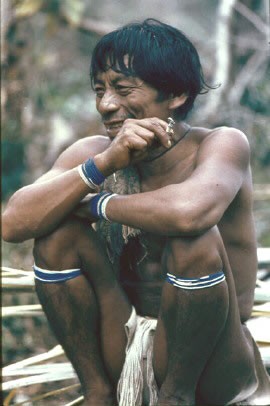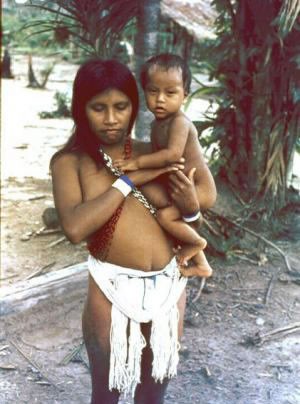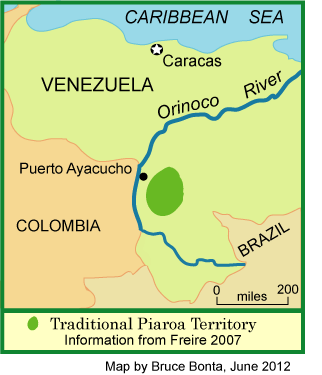Location. About 14,000 Piaroa Indians live in or near tropical forests to the east of the Middle Orinoco River in Amazonas State, Venezuela. They used to be shifting cultivators but they now live in permanent communities inside their traditional territory, in nearby areas, and at other scattered locations in Venezuela and Colombia.

Economy. The Piaroa used to subsist on shifting cultivation, fishing, hunting, gathering and trading craft products, but in recent decades their economy has grown more complex. They now live in more stable settlements where they accept modernizing trends, grow crops in permanent gardens, raise livestock, earn money through wage labor, buy modern consumer goods, and get educations so they can become nurses, teachers, or other professionals. Some Piaroa who live near enough to the Amazonas State capital, Puerto Ayacucho, take produce and goods into the city to sell on market days. A news story in 2012 reported how one Piaroa community is trying to prevent forest fragmentation, minimize soil erosion, preserve river banks, support the use of indigenous crops, and help retain traditional land use practices.
Beliefs that Foster Peacefulness. The Piaroa believe in a violently creative mythic past when their gods achieved material and technological prosperity only through competition, violence, greed, arrogance, and lust, traits that, they believe, poisoned peaceful relations within and between communities. Their present society fosters its creativity by controlling that mythic period and by focusing on individuals who live peacefully together—the antidote to those past excesses of wanton wildness. Their communities, in fact, are almost completely peaceful, but they still face the threatened violence of their mythic past. In order to control that violence, the shaman chants every night and blows his words into water and honey which, consumed the next morning by adults and children, will keep them safe for another day. The Piaroa shamans also consume several psychoactive drugs for several purposes, including an anti-depressant that helps keep the people peaceful.
Gender Relations. The Piaroa believe that the ideal meal is composed of meat and manioc bread, the product of a man’s hunting and a woman’s garden. Their ideal for both men and women is tranquility and control—a mastery of the emotions. They are quite strongly egalitarian and supportive of individual autonomy.

Raising Children. The Piaroa shaman in each community gathers children together when they reach six or seven years of age for lessons on personal responsibility, self-restraint, and respect for others. He instructs them how to avoid quarrels and control jealousy, arrogance, malice, dishonesty, vanity, and cruelty. He teaches them that emotions and desires must be mastered, a process that allows responsibility to develop along with the free will to respect others. Piaroa children have no models for violent or coercive behavior, they are not punished physically, and their play is robust but free of expressions of anger. Adults discourage temper tantrums, pointedly disapproving through their silence any displays of anger. Young people do not engage in competitive sports.
Social Practices. The Piaroa place a very high value on personal autonomy, informal social life, and tranquil interpersonal relationships. They constantly proclaim the right of the individual to choose how to do things, and they would not comment negatively on decisions of others regarding their work, food choices, sexual habits, or residence. Decisions as to where a married couple should live are made based on their perceptions of what is right and best. The work of the day is loosely organized according to individual choices and moods—no one feels compelled to do things. Social values that promote individuals, such as personal industry, talent, ambition, and courage are discouraged.
Cooperation and Competition. The Piaroa view competition as leading to cannibalism. They feel that competition over resources and over the power to transform the resources of the earth into human goods is the primary force producing human violence. They believe their political process should reject competition and the ownership and control of resources. In fact, however, their political leaders do compete for position, especially by making strategic marriage alliances.
 Social Control. The Piaroa maintain their peacefulness by the use of healing therapy rather than by imposing authority systems, civil laws or criminal laws. Their ideology completely forbids any physical coercion or violence. They feel they have abolished the use of coercion by eliminating the ownership of material resources and the control over other people’s labor.
Social Control. The Piaroa maintain their peacefulness by the use of healing therapy rather than by imposing authority systems, civil laws or criminal laws. Their ideology completely forbids any physical coercion or violence. They feel they have abolished the use of coercion by eliminating the ownership of material resources and the control over other people’s labor.
Sharing. The produce of the forest is shared by all the members of the multi-family houses in which they live, but the products from gardens are owned individually by the people who grow them. Individuals are free to choose how much they wish to be part of any collective activity—there is no coercion in their society, which has no authority over people. While the concept of a collective will is foreign to them, the Piaroa highly value social skills and the ability to live together in a community. The Huarime festivals held in Piaroa communities emphasize the importance of sharing in their society.
Strategies for Avoiding Warfare and Violence. The largest political unit of the Piaroa is their Itso’fha, their territory, of which there are roughly 12 to 15. One of the fundamental achievements of their society is that they have institutionalized peace between their communities. Armed conflicts between territories are unthinkable and their communities are almost completely free of physical violence. A Piaroa who killed another man, they believe, would himself die by defecating out his insides. Their prohibition against killing includes not only people within their own territories but also outsiders. The Piaroa have had a mostly peaceful history of relations with their neighboring societies.
But How Much Violence Do They Really Experience? Joanna Overing, an anthropologist who has written extensively about the Piaroa, wrote in 1986 (p.88) that, “Piaroaland is a place almost totally free of all forms of physical violence, where children, teenagers, and adults alike never express their anger through physical means.” However, while outsiders see them as highly peaceful, in their own view the diseases and deaths they suffer are a result of extreme violence—sorcery—by outsiders. To retaliate, they actively use sorcery against the unknown individuals who have attacked them.
Scholarly Resources in this Website:
- “Styles of Manhood: An Amazonian Contrast in Tranquility and Violence.” (Overing, 1989)
More Resources in this Website:
- Guerillas from neighboring Colombia have threatened the stability of the Piaroa communities.
- The Piaroa perceive mining in their territory to be a threat to their lives, their environment, and their cultural values, and in July 2013 they protested volubly.
- Piaroa women began their own protests about the violence caused by miners and guerillas late in 2014.
- A medical team visited one Piaroa community and found that health conditions are not too good.
Sources in Print: Freire 2007; Overing 1985, 1986, 1988, 1989a, 1989b; Overing Kaplan 1975; Zent 1994
Sources on the Web: APFT Pilot Report: Piaroa; Wikipedia (English Version); Indígenas de Venezuela: los Piaroa (Parte I)
Updates—News and Reviews:
Selected Recent Stories
November 12, 2015. Hallucinogens for the Piaroa
October 8, 2015. Theatre Production about Piaroa Gardens
February 19, 2015. Coltan Mining Fosters Violence
June 12, 2014. Huarime Festival in a Piaroa Community
All Stories
All stories in this website about the Piaroa are listed in the News and Reviews Subject Listing
